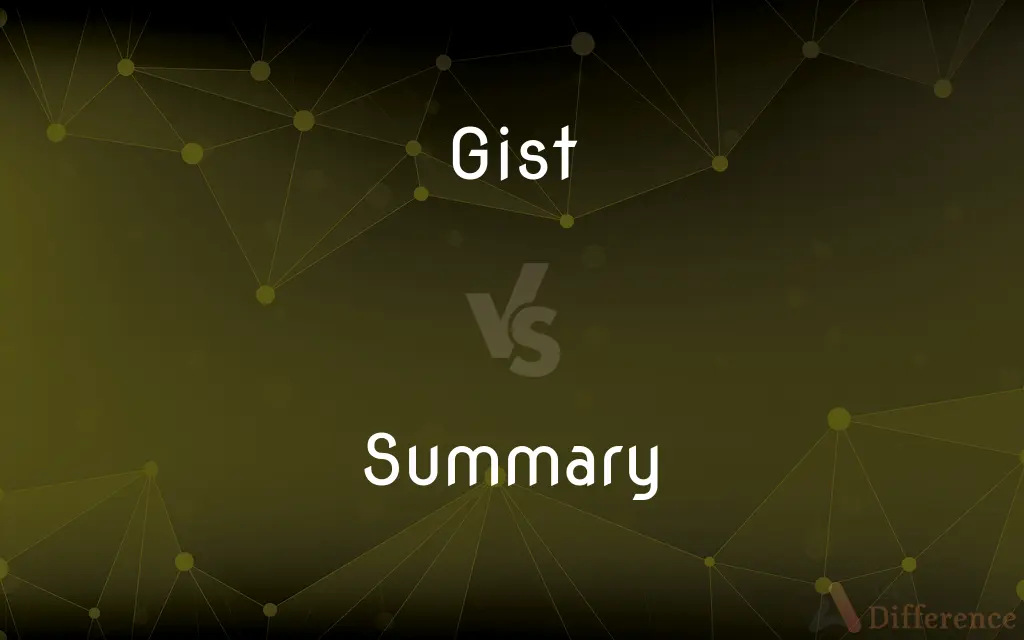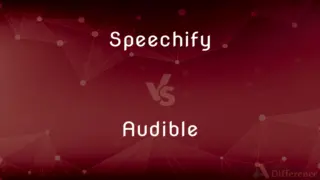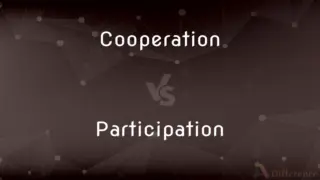Gist vs. Summary — What's the Difference?
By Maham Liaqat & Fiza Rafique — Updated on April 8, 2024
The gist captures the main idea or essence of a text or conversation, focusing on the core message, while a summary provides a condensed version, detailing key points and often including supporting details.

Difference Between Gist and Summary
Table of Contents
ADVERTISEMENT
Key Differences
The gist of a text or conversation involves understanding and conveying its central theme or essential point, often in a brief statement or thought. It is about grasping the core idea more than recounting all the details or developments. For instance, the gist of a story could be its moral or the main event around which the plot revolves. In contrast, a summary aims to shrink the full content into a shorter form, touching upon major points, key arguments, outcomes, and occasionally significant details to provide a comprehensive overview.
Understanding the gist requires less engagement with the material than summarizing. When someone asks for the gist, they're typically looking for a quick insight into the material's main idea without the expectation of detailed information. On the other hand, creating a summary demands a thorough understanding and often a reorganization of the original content into a more compact form, including various elements like the introduction, body, and conclusion, depending on the context.
The purpose of conveying the gist can differ from that of a summary. The gist is often shared in informal settings or when time is limited, serving to quickly inform or make a point without delving into complexities. Summaries, however, are used in both academic and professional contexts to encapsulate longer texts, presentations, or meetings, providing a clear and concise rendition of the original material for those who may not have access to or time for the full version.
The length and detail of a gist compared to a summary also vary significantly. A gist can be as short as a sentence or two, capturing only the very heart of the subject. A summary, while still shorter than the original text, is usually longer than the gist and includes various points that give a fuller picture of the material.
Both the gist and a summary are valuable tools for communication and understanding. While the gist offers a quick snapshot, a summary provides a miniature version of the original, each serving different needs based on the audience's requirements, the context of the discussion, and the complexity of the material being addressed.
ADVERTISEMENT
Comparison Chart
Focus
Central theme or main idea
Condensed version including key points and details
Engagement Needed
Less, focuses on understanding the core message
More, involves detailed recounting and condensation
Purpose
Quick insight in informal settings or under time constraints
Comprehensive overview for academic or professional contexts
Length and Detail
Brief, possibly one or two sentences
Longer, covering various points for a fuller picture
Usage Scenario
Informal discussions, quick explanations
Academic summaries, professional reports, detailed overviews
Compare with Definitions
Gist
Main Idea or Essence.
The gist of the novel is the journey of self-discovery in adversity.
Summary
Academic and Professional Use.
Summaries are essential in academic papers and professional documents for clarity.
Gist
Less Detailed.
The gist often leaves out finer details to focus on the core message.
Summary
More Detailed than Gist.
Summaries provide a comprehensive overview, including supporting details.
Gist
Quick Insight.
He gave me the gist of the conversation, which was about upcoming company changes.
Summary
Includes Key Points.
A good summary captures the introduction, major arguments, and the final stance.
Gist
Informal Communication.
In casual talk, sharing the gist is common to convey the main point quickly.
Summary
Thorough Engagement.
Summarizing demands a full understanding and reorganization of the original content.
Gist
Core Understanding.
Understanding the gist requires grasping the central theme more than the specifics.
Summary
Condensed Version.
The summary of the report outlines the objectives, methodology, findings, and conclusions.
Gist
The central idea; the essence.
Summary
A brief statement mentioning the main points of something
A summary of our findings.
Gist
(Law) The grounds for action in a suit.
Summary
Prose that provides information in a condensed format, as by mentioning only the most significant details of a narrative
The novelist did not like writing dialogue and preferred to write stories in summary.
Gist
The most essential part; the main idea or substance (of a longer or more complicated matter); the crux of a matter; the pith.
Summary
Presenting the substance in a condensed form; concise
A summary review.
Gist
The essential ground for action in a suit, without which there is no cause of action.
Summary
Performed speedily and without ceremony
Summary justice.
A summary rejection.
Gist
(obsolete) Resting place (especially of animals), lodging.
Summary
Concise, brief or presented in a condensed form
A summary review is in the appendix.
Gist
To summarize, to extract and present the most important parts of.
Summary
Performed speedily and without formal ceremony.
They used summary executions to break the resistance of the people.
Gist
A resting place.
These quails have their set gists; to wit, ordinary resting and baiting places.
Summary
(legal) Performed by skipping the procedures of a standard and fair trial.
Summary justice is bad justice.
Gist
The main point, as of a question; the point on which an action rests; the pith of a matter; as, the gist of a question.
Summary
An abstract or a condensed presentation of the substance of a body of material.
Make a summary of the events
Gist
The central meaning or theme of a speech or literary work
Summary
Formed into a sum; summed up; reduced into a narrow compass, or into few words; short; brief; concise; compendious; as, a summary statement of facts.
Gist
The choicest or most essential or most vital part of some idea or experience;
The gist of the prosecutor's argument
The heart and soul of the Republican Party
The nub of the story
Summary
Hence, rapidly performed; quickly executed; as, a summary process; to take summary vengeance.
Summary
A general or comprehensive statement; an abridged account; an abstract, abridgment, or compendium, containing the sum or substance of a fuller account.
Summary
A briefstatement that presents the main points in a concise form;
He gave a summary of the conclusions
Summary
Performed speedily and without formality;
A summary execution
Summary justice
Summary
Briefly giving the gist of something;
A short and compendious book
A compact style is brief and pithy
Succinct comparisons
A summary formulation of a wide-ranging subject
Common Curiosities
Can a summary replace the original text?
While it provides a condensed overview, it may not capture all nuances or the depth of the original.
What makes a good summary?
It accurately condenses the main points and relevant details, providing a clear overview without distortion.
Why is understanding the gist important?
It helps quickly grasp the main idea, useful in fast-paced discussions or when skimming content.
Is it easier to convey the gist or a summary?
Conveying the gist is typically easier and quicker, as it requires less detail than a summary.
When might one prefer a summary over the gist?
When needing a comprehensive understanding without reading the full original material, especially in academic or professional settings.
How long should a summary be?
It varies, but it should be significantly shorter than the original while still covering all essential points.
How do you identify the gist of a text?
By focusing on the central theme or idea, often found in the thesis statement or conclusion.
Are there tools to help identify the gist or create summaries?
Yes, various reading strategies and software tools can aid in highlighting key points and condensing texts.
Can the gist be misleading?
If oversimplified, it might miss critical nuances, leading to misunderstandings of the full content.
How does one improve at identifying the gist or summarizing?
Practice, along with active reading strategies and understanding of the material's structure, can enhance these skills.
Share Your Discovery

Previous Comparison
Speechify vs. Audible
Next Comparison
Cooperation vs. ParticipationAuthor Spotlight
Written by
Maham LiaqatCo-written by
Fiza RafiqueFiza Rafique is a skilled content writer at AskDifference.com, where she meticulously refines and enhances written pieces. Drawing from her vast editorial expertise, Fiza ensures clarity, accuracy, and precision in every article. Passionate about language, she continually seeks to elevate the quality of content for readers worldwide.















































